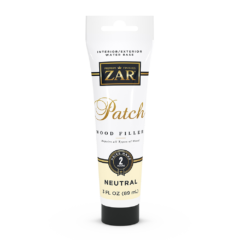
Wood is undoubtedly durable and long-lasting, yet it isn’t indestructible. Solid wood may develop fractures, cavities, divots, scratches and scars when exposed to moisture or general wear and tear. The fastest way to make repairs is to use wood filler.
Wood filler can fill in cracks, mend nail holes and hide other flaws regardless of whether you’re working with wood floors, cabinets, furniture or an outside surface. This article will discuss the best way to hide wood filler repairs after they’ve been stained.
What is Wood Filler?
Wood filler is a substance used to repair holes in wood. It can be used to fill nail holes and dents, as well as defects as small as grain irregularities in wide boards, so that stain and finish are absorbed uniformly.

Fillers are normally composed of a binder and a filling component. Professional-grade materials are created that have the texture of putty. Working with this sort of wood filler is simpler and is available in many colors that may be matched to the project for consistent finishing results.
Latex fillers are one of the most popular types, and they’re water-based for simple cleanup. Latex fillers may be used to repair big cracks and holes in unfinished wood because they mix well with dyes. Epoxy and polyurethane fillers are also useful in the workshop. However, epoxy fillers should only be used on unfinished wood because sanding them requires more work that may destroy the finish.

Why is Staining Over Wood Filler a Challenge?
When staining, there’s always the danger that the wood filler won’t absorb the stain.
The stain may fail to adhere to the wood filler.
After some time, it might wipe away.
The color of the stain on the filler may appear lighter than the actual wood.
How to Match Wood Filler with Stain
The following instructions are based on latex wood fillers. Follow these simple steps to obtain the best results when stain-matching.
Use it only when the material and/or air temperature is above 40°F.
Remove any dirt, grease, oil or loose particles from the patched area.
Water should be used to dampen the surfaces to be patched.
Step 1 — Sand the Wood in Question

Use a finer grade of sandpaper, such as 120 or higher. Sand the area where the wood filler will be applied. While sanding, use equal pressure, though a little more force may be needed on the filler. This step is not necessary if you’ve previously sanded the project while putting in the wood filler.
Step 2 — Clean Wood and Sanding Dust
Use a lightly dampened rag or tack cloth to remove any dust that remains.
Step 3 — Apply Pre-Stain Conditioner
To level out the color when working with natural woods, you may use a pre-stain wood treatment. The conditioner works by getting into and briefly sealing the wood, which allows for a more uniform stain coat.
Step 4 — Apply the Stain

Allow the patch to dry overnight before applying an oil-based stain, paint, varnish, shellac or polyurethane. In the case of latex paints or stains, you only need to wait 1.5 to 2 hours after applying the wood filler. Apply a top coat of paint or solid color stain within 24 hours for all outdoor applications. These fillers are not recommended for use on outside wooden decks or other external horizontal surfaces.

Step 5 — Apply Protective Finish
A high-quality clear sealant benefits wood in two primary ways: protection and decoration. Protection from dampness, either in the form of liquid or vapor (humidity), or scratches, dirt and wear. The thicker the finish, the more moisture-resistant it is.

Once the paint or stain has completely dried, you should apply a protective clear-coat finish. ZAR® has a complete line of clear sealants that will work over latex and oil-based paints and stains.
Work with ZAR® to Take the Best Care of Your Home’s Wood
ZAR Patch Wood Filler is a latex compound that contractors and DIYers use to fill nail holes, mend cracks, gouges, broken corners, minor flaws and chipped edges on wood surfaces. Because it only shrinks a little and can be nailed, sawed, sanded or drilled, it’s perfect for a wide range of applications. Our Patch Wood Filler can be used indoors and outside, and it accepts paint, varnish and shellac. Plus, it absorbs stain more readily than traditional wood patching materials, making it the perfect choice for your next project.
Contact us today to find a retailer near you, and check out our website for other great wood-protecting products.



